Modeling American Household Fluid Milk Consumption and their Resulting Greenhouse Gas Emissions
Abstract
:1. Introduction
2. Materials and Methods
2.1. Discrete Event Simulation
2.2. How the Consumer Was Modeled Using DES
2.3. Determining Model Parameters
- Type—Number used to indicate the type of consumption event (1 = coffee/tea, 2 = drink, 3 = cereal, 4 = cooking)
- Amount—Number to indicate the amount of milk in mL to be consumed
- Path—Number used to route the entity through the model
2.4. Representing Different Household Types
3. Results
3.1. Understanding How Packaging Affects Milk Consumption and Spoilage
3.2. Greenhouse Gas Emissions of Milk Consumption, Packaging, and Spoilage
4. Discussion
5. Conclusions
Supplementary Materials
Author Contributions
Funding
Acknowledgments
Conflicts of Interest
Appendix A
| Terms | Definitions |
|---|---|
| Event | An observation of an instantaneous incident that may change a state variable, an output, and/or the occurrence of other events. Events can correspond to changes in the state of an entity. |
| Entity | Pass through a network of queues, servers, gates, and switches during a simulation. Entities can carry data, known in SimEvents software as attributes. |
| Intergeneration times for entities | The intergeneration time is the time interval between successive entities that the block generates. You can have a generation process that is: periodic, sampled from a random distribution, and from custom code. |
| Seed | Value used by the random number generator to generate random numbers within the model. |
| Symbol | Definition |
|---|---|
 Entity Generator | Generate entities using intergeneration times from dialog or upon arrival of events. |
 Entity Server | Serve multiple entities independently for a period and then attempt to output each entity through the output port. If the output port is blocked, the pending entity stays in this block until the port becomes unblocked. You can specify the service time, which is the duration of service. |
 Entity Terminator | Accept and destroy entities. |
 Entity Queue | Store entities in a queue. The entity at the head of the queue departs when the downstream block is ready to accept it. You can specify the queue capacity and queuing policy. |
 Entity Output Switch | Route entities to 1 of the multiple output ports. The port selected for departures can change during the simulation. |
 Entity Input Switch | Allows for arrival of multiple entities at its ports. Outputs 1 entity at a time. The selected entity input port can change during the simulation. |
 Entity Gate | Controls the flow of entities by opening and closing a gate. Allows 1 entity to advance for each message that arrives on the control port. |
 Out 1 | Provide an output port for a subsystem or model. |
 In 1 | Provide an input port for a subsystem or model. |
| Attributes | Definition |
|---|---|
| ContainerID | Unique identification number assigned to each container |
| ContainerVolume | Number indicating the amount of milk the container can hold in mL |
| MilkVolume | Number indicating the amount of milk in the container in mL |
| UseBy | Number indicating the use-by date |
| IsOpen | Number used to indicate of the container has been opened (0 = unopened, 1 = opened) |
| MilkVolume | Number indicating the amount of milk in the container in mL |
| Path | Number used to route the entity through the model |
| Parameters | Shelf Life* in Days (7, 14, 21) | Probability of Going to Market (0.25, 0.5, 1) | Size of Container (Quart, Half Gallon, Gallon) | Number of Containers (1, 2, 3) | |
|---|---|---|---|---|---|
| Response Variables | Amount Unavailable | Amount Available | Amount Requested | Amount Consumed | Containers Available |
| Milk from Grocery store | Milk from Market | Amount Spoiled | Amount Wasted | ||
| Child 2–3 | Child 9–18 | Adult 19+ | |||||||
|---|---|---|---|---|---|---|---|---|---|
| TD | Pr (%) | Amount (mL) | TD | Pr (%) | Amount (mL) | TD | Pr (%) | Amount (mL) | |
| Coffee/Tea | 0 | 0 | 0 | 0 | 0 | 0 | 2 | 50 | 20 |
| Drinking | 3 | 50 | 250 | 2 | 35 | 250 | 1 | 35 | 200 |
| Cereal | 1 | 50 | 300 | 1 | 50 | 300 | 1 | 50 | 200 |
| Cooking | 1 | 15 | 300 | 1 | 15 | 300 | 1 | 15 | 600 |
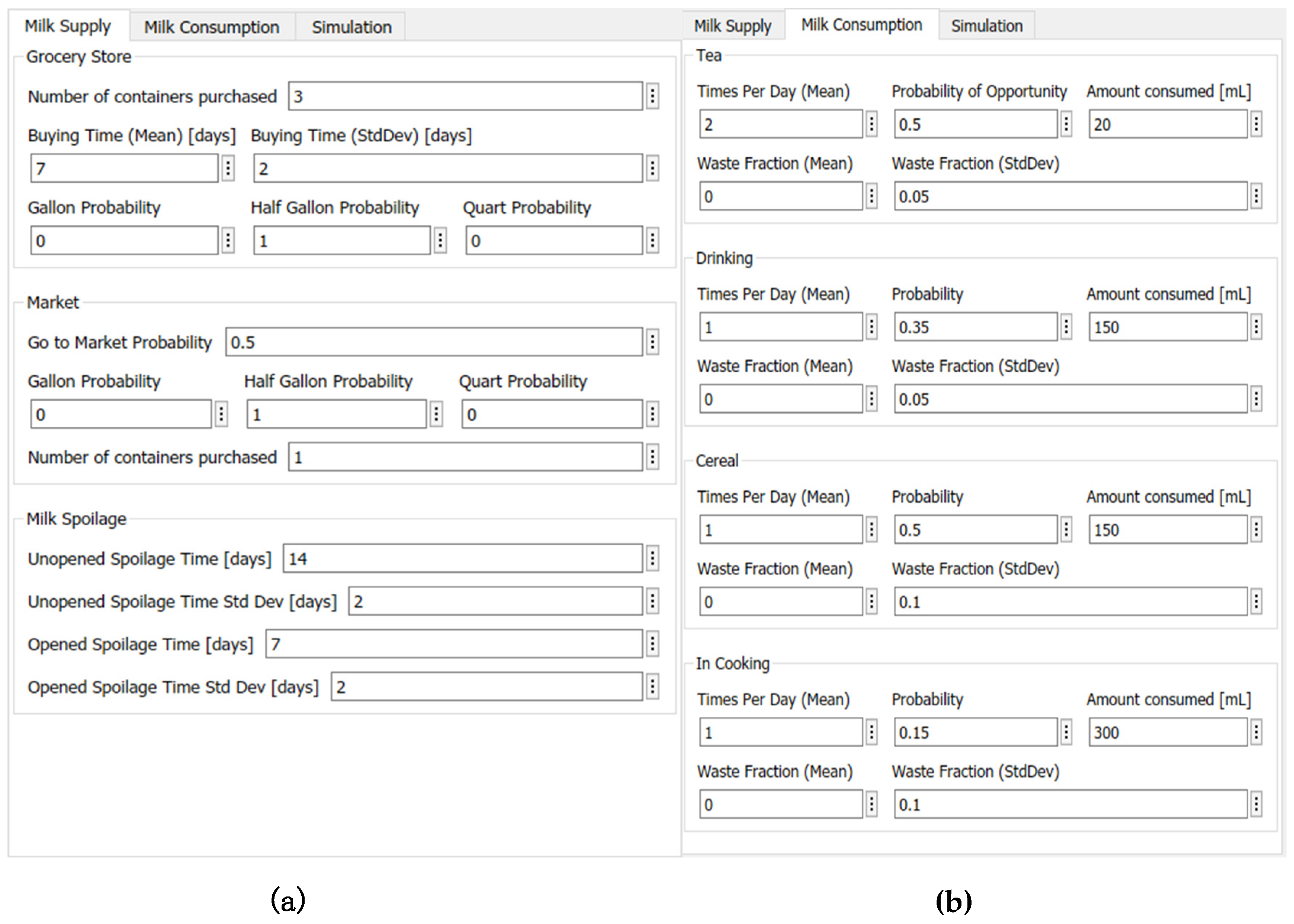
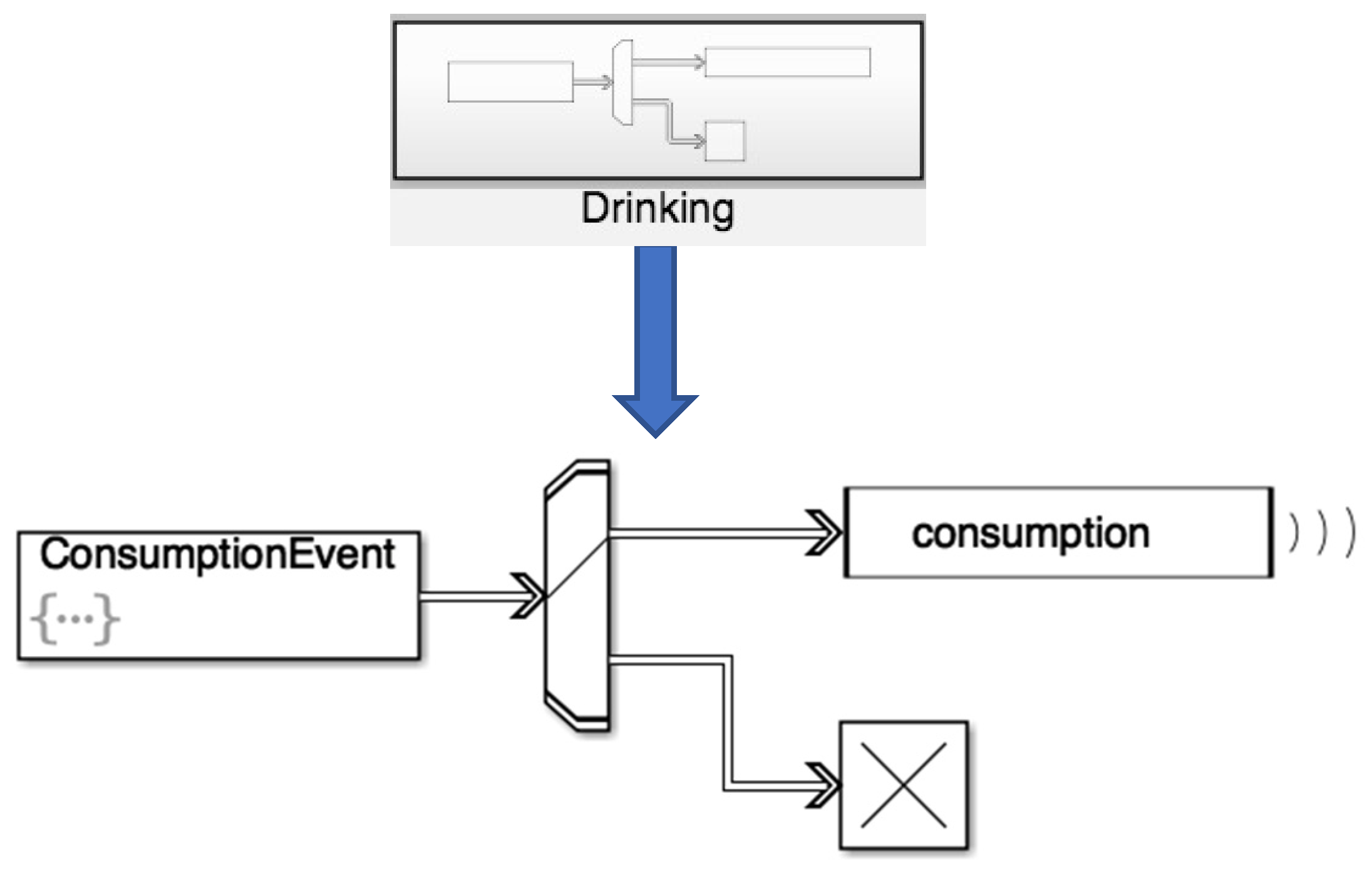
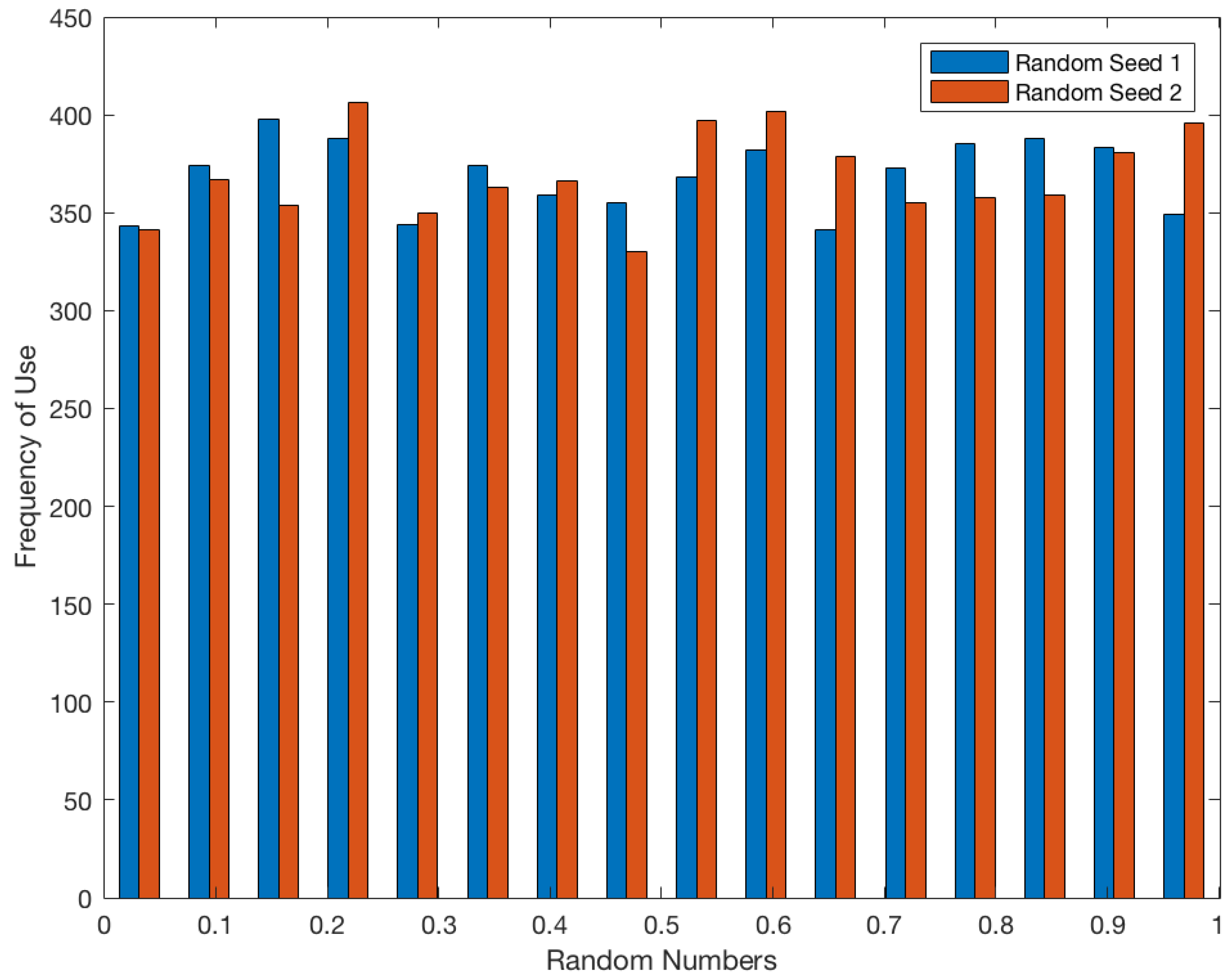
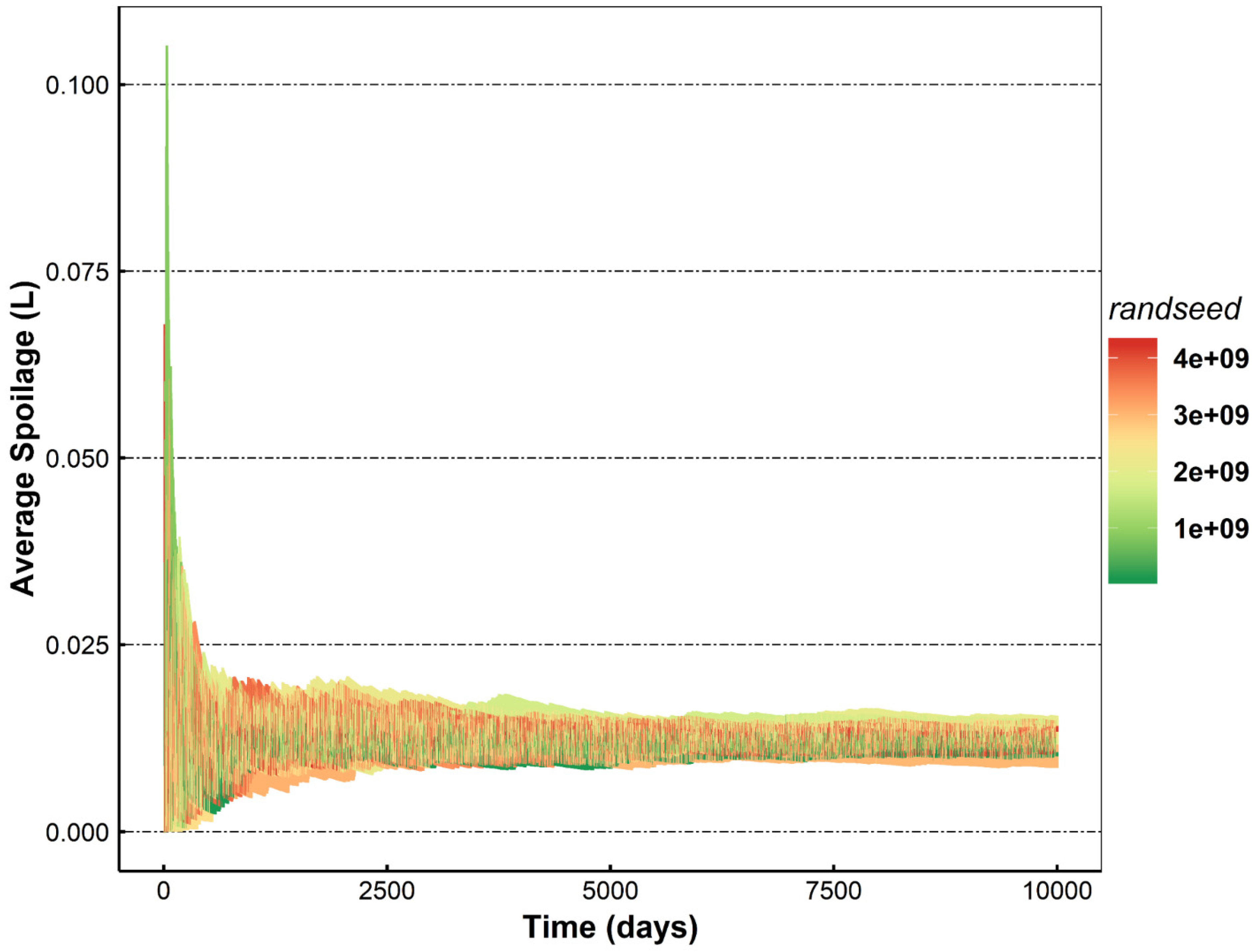
| Container Type | Probability of Purchase at Grocery Store (%) | Probability of Purchase at Top-up Shop (%) | ||||
|---|---|---|---|---|---|---|
| Household Type | 1P | 2P | 4P | 1P | 2P | 4P |
| Half Gallon | 0 | 100 | 0 | 0 | 100 | 100 |
| Gallon | 0 | 0 | 100 | 0 | 0 | 0 |
| Quart | 100 | 0 | 0 | 100 | 0 | 0 |
| Container Type | Market Share (%) |
|---|---|
| Monolayer HDPE chilled 1 gallon | 65 |
| Monolayer HDPE chilled 1/2 gallon | 10 |
| Gable Top carton chilled 1/2 gallon | 8 |
| Monolayer HDPE chilled quart | 1.5 |
| Others * | 15.5 |

References
- Gustavsson, J.; Cederberg, C.; Sonesson, U.; Meybeck, A.; van Otterdijk, R. Global Food Losses and Food Waste; Food and Agriculture Organization of the United Nations: Rome, Italy, 2011. [Google Scholar]
- Mandyck, J.M.; Schultz, E.B. Food Foolish: The Hidden Connection Between Food Waste, Hunger and Climate Change, 1st ed.; Carrier Corp: Farmington, CT, USA, 2015; ISBN 0692456325. [Google Scholar]
- Buzby, J.C.; Hyman, J. Total and per capita value of food loss in the United States. Food Policy 2012, 37, 561–570. [Google Scholar] [CrossRef]
- Bigelow, P.D.; Borchers, A. Major Uses of Land in the United States. 2017. Available online: https://naldc.nal.usda.gov/download/CAT93502180/PDF (accessed on 9 April 2019).
- Toth, J.D.; Dou, Z. Wasted Food, Wasted Resources: Land, Irrigation Water, and Nutrients Associated with Food Wastage in the U.S. In Food Waste Across the Supply Chain: A US Perspective On a Global Problem; Dou, Z., Ferguson, J.D., Galligan, D.T., Kelly, A.M., Finn, S.M., Giegengack, R., Eds.; Council for Agricultural Science and Technology: Ames, IA, USA, 2016; pp. 57–71. ISBN 978-1532835070. [Google Scholar]
- Clune, S.; Crossin, E.; Verghese, K. Systematic review of greenhouse gas emissions for different fresh food categories. J. Clean. Prod. 2017, 140, 766–783. [Google Scholar] [CrossRef] [Green Version]
- Williams, H.; Wikström, F. Environmental impact of packaging and food losses in a life cycle perspective: A comparative analysis of five food items. J. Clean. Prod. 2011, 19, 43–48. [Google Scholar] [CrossRef]
- Møller, H.; Soukka, R.; Wikström, F.; Olsson, A.; Auras, R.; Kvalvåg Pettersen, M.; Wever, R.; Williams, H.; Verghese, K.; Grönman, K. Packaging Strategies That Save Food: A Research Agenda for 2030. J. Ind. Ecol. 2018. [Google Scholar] [CrossRef]
- Schmidt, K.; Matthies, E. Where to start fighting the food waste problem? Identifying most promising entry points for intervention programs to reduce household food waste and overconsumption of food. Resour. Conserv. Recycl. 2018, 139, 1–14. [Google Scholar] [CrossRef]
- Aschemann-Witzel, J.; de Hooge, I.; Amani, P.; Bech-Larsen, T.; Oostindjer, M. Consumer-Related Food Waste: Causes and Potential for Action. Sustainability 2015, 7, 6457–6477. [Google Scholar] [CrossRef] [Green Version]
- Thoma, G.; Popp, J.; Nutter, D.; Shonnard, D.; Ulrich, R.; Matlock, M.; Kim, D.S.; Neiderman, Z.; Kemper, N.; East, C.; et al. Greenhouse gas emissions from milk production and consumption in the United States: A cradle-to-grave life cycle assessment circa. Int. Dairy J. 2013, 31, S3–S14. [Google Scholar] [CrossRef]
- Hebrok, M.; Boks, C. Household food waste: Drivers and potential intervention points for design—An extensive review. J. Clean. Prod. 2017, 151, 380–392. [Google Scholar] [CrossRef]
- Neff, R.A.; Spiker, M.L.; Truant, P.L. Wasted food: U.S. consumers’ reported awareness, attitudes, and behaviors. PLoS ONE 2015, 10, e0127881. [Google Scholar] [CrossRef]
- Wilson, N.L.W.W.; Rickard, B.J.; Saputo, R.; Ho, S.T. Food waste: The role of date labels, package size, and product category. Food Qual. Prefer. 2017, 55, 35–44. [Google Scholar] [CrossRef] [Green Version]
- Williams, H.; Wikström, F.; Otterbring, T.; Löfgren, M.; Gustafsson, A. Reasons for household food waste with special attention to packaging. J. Clean. Prod. 2012, 24, 141–148. [Google Scholar] [CrossRef] [Green Version]
- Schanes, K.; Dobernig, K.; Gözet, B. Food waste matters—A systematic review of household food waste practices and their policy implications. J. Clean. Prod. 2018, 182, 978–991. [Google Scholar] [CrossRef]
- Karli, V.; Helen, L.; Simon, L.; Helen, W. The Role of Packaging in Minimising Food Waste in the Supply Chain of the Future; RMIT University: Melbourne, Australia, 2013. [Google Scholar]
- Quested, T.E.; Marsh, E.; Stunell, D.; Parry, A.D. Resources, Conservation and Recycling Spaghetti soup: The complex world of food waste behaviours. Resour. Conserv. Recycl. 2013, 79, 43–51. [Google Scholar] [CrossRef]
- Licciardello, F. Packaging, blessing in disguise. Review on its diverse contribution to food sustainability. Trends Food Sci. Technol. 2017, 65, 32–39. [Google Scholar] [CrossRef]
- Molina-Besch, K.; Wikström, F.; Williams, H. The environmental impact of packaging in food supply chains—Does life cycle assessment of food provide the full picture? Int. J. Life Cycle Assess. 2019, 24, 37–50. [Google Scholar] [CrossRef]
- Wikström, F.; Williams, H.; Venkatesh, G. The influence of packaging attributes on recycling and food waste behaviour—An environmental comparison of two packaging alternatives. J. Clean. Prod. 2016, 137, 895–902. [Google Scholar] [CrossRef]
- Wikström, F.; Williams, H.; Verghese, K.; Clune, S. The influence of packaging attributes on consumer behaviour in food-packaging life cycle assessment studies—A neglected topic. J. Clean. Prod. 2014, 73, 100–108. [Google Scholar] [CrossRef]
- Buzby, J.C.; Farah-Wells, H.; Hyman, J. The Estimated Amount, Value, and Calories of Postharvest Food Losses at the Retail and Consumer Levels in the United States; U.S. Department of Agriculture, Economic Research Service: Washington, DC, USA, 2014. [Google Scholar]
- Quested, T. The Milk Model: Simulating Food Waste in the Home; WRAP: Banbury, UK, 2013. [Google Scholar]
- Robinson, S. Discrete-event simulation: A primer. In Discrete-Event Simulation and System Dynamics for Management Decision Making; Brailsford, S., Churilov, L., Dangerfield, B., Eds.; John Wiley & Sons, Ltd.: Loughborough, UK, 2014; pp. 10–25. [Google Scholar]
- MATLAB and Simulink Toolbox R2018a; The MathWorks, Inc.: Natick, MA, USA, 2018.
- Barbano, D.M. A 100-Year Review: The production of fluid (market) milk. J. Dairy Sci. 2017, 100, 9894–9902. [Google Scholar] [CrossRef]
- American Community Survey 5-Year Detailed Tables. Available online: https://api.census.gov/data/2016/acs/acs5/tags/household.html (accessed on 27 February 2019).
- Average Daily Servings of Dairy Foods by Ethnicity and Age Group (NHANES 2011–2014); NHANES: Atlanta, GA, USA, 2014.
- Burek, J.; Kim, D.; Nutter, D.; Selke, S.; Auras, R.; Cashman, S.; Sauer, B.; Thoma, G. Environmental Sustainability of Fluid Milk Delivery Systems in the United States. J. Ind. Ecol. 2017, 22, 180–195. [Google Scholar] [CrossRef]
- Morone, P.; Falcone, P.M.; Lopolito, A. How to promote a new and sustainable food consumption model: A fuzzy cognitive map study. J. Clean. Prod. 2018, 208, 563–574. [Google Scholar] [CrossRef]
- Jun, J.B.; Jacobson, S.H.; Swisher, J.R. Application of Discrete-Event Simulation in Health Care Clinics: A Survey. J. Oper. Res. Soc. 1999, 50, 109–123. [Google Scholar] [CrossRef]
- USDA. Packaged Fluid Milk Sales in Federal Milk Order Markets: By Size and Type of Container and Distribution Method During November 2005; USDA: Washington, DC, USA, 2005.
- Thyberg, K.L.; Tonjes, D.J. Drivers of food waste and their implications for sustainable policy development. Resour. Conserv. Recycl. 2016, 106, 110–123. [Google Scholar] [CrossRef]
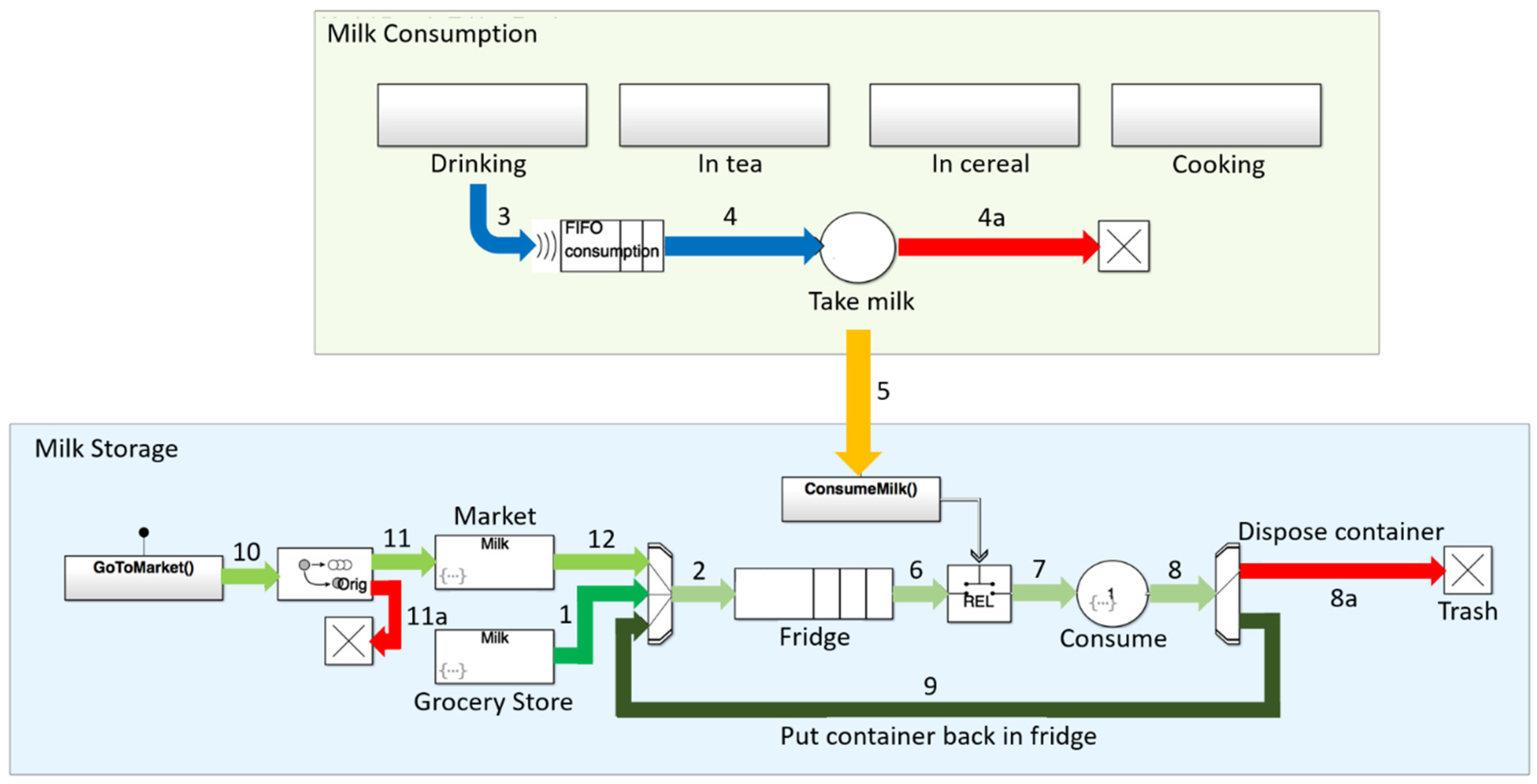

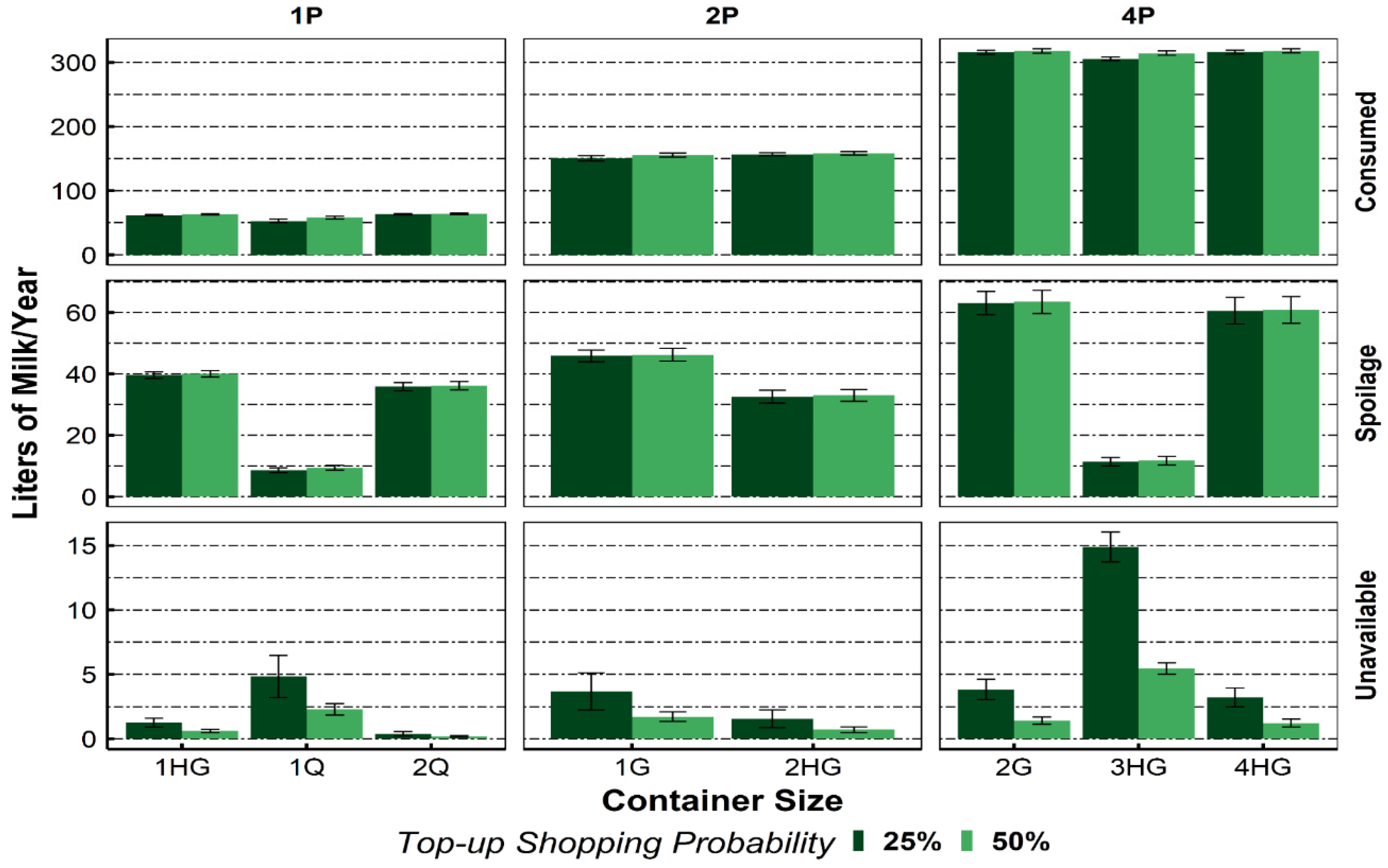
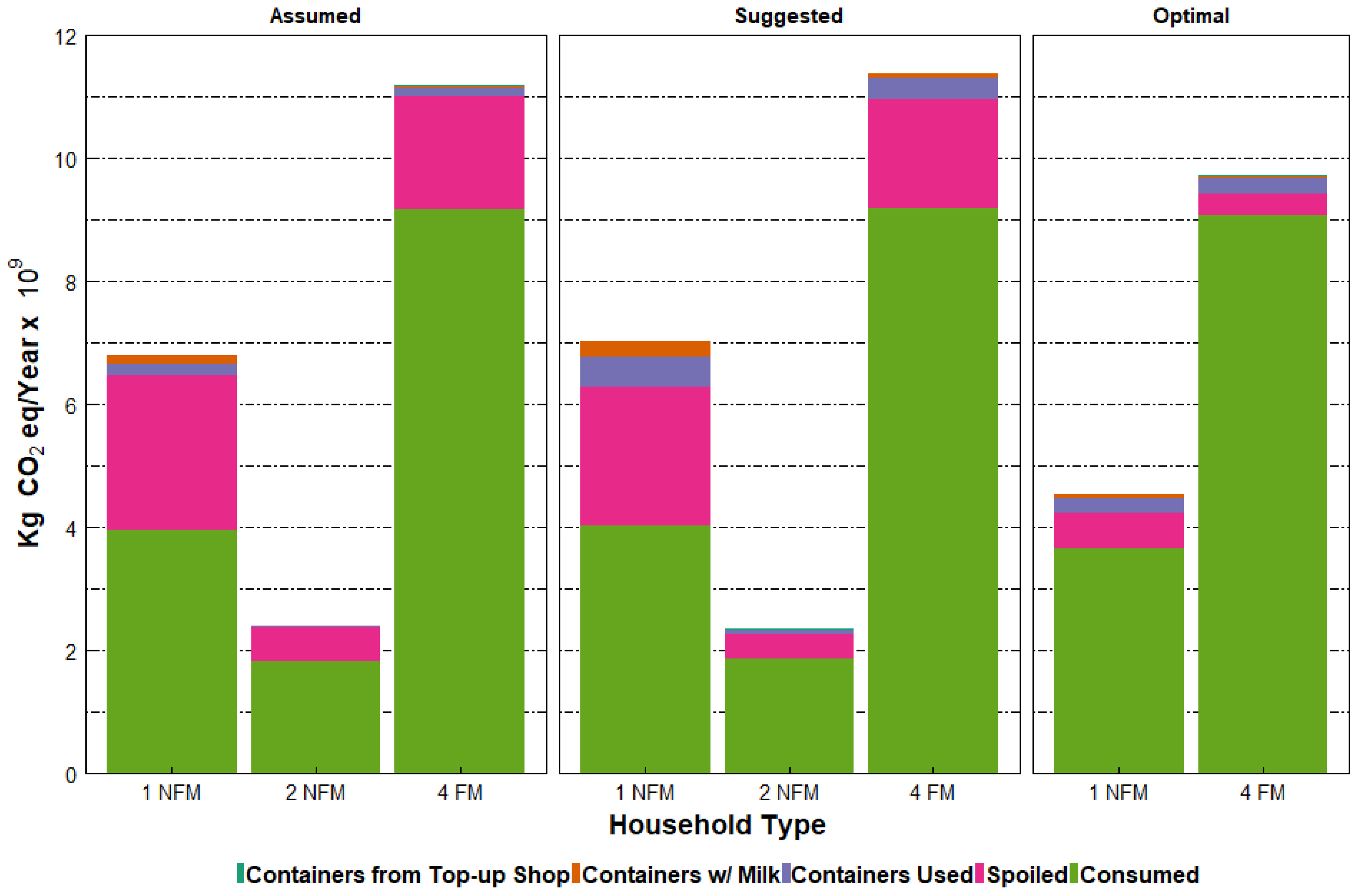
© 2019 by the authors. Licensee MDPI, Basel, Switzerland. This article is an open access article distributed under the terms and conditions of the Creative Commons Attribution (CC BY) license (http://creativecommons.org/licenses/by/4.0/).
Share and Cite
Stankiewicz, S.K.; Auras, R.; Selke, S. Modeling American Household Fluid Milk Consumption and their Resulting Greenhouse Gas Emissions. Sustainability 2019, 11, 2152. https://doi.org/10.3390/su11072152
Stankiewicz SK, Auras R, Selke S. Modeling American Household Fluid Milk Consumption and their Resulting Greenhouse Gas Emissions. Sustainability. 2019; 11(7):2152. https://doi.org/10.3390/su11072152
Chicago/Turabian StyleStankiewicz, Sebastian K., Rafael Auras, and Susan Selke. 2019. "Modeling American Household Fluid Milk Consumption and their Resulting Greenhouse Gas Emissions" Sustainability 11, no. 7: 2152. https://doi.org/10.3390/su11072152






